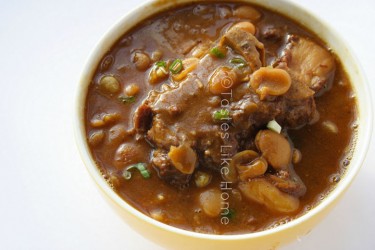Hi Everyone, The secret to a good Trini Pelau or Stew is burnt sugar.
Burnt sugar is essentially sugar that has melted and caramelized. Burnt sugar has notes of sweetness with very subtle complex hints of bitterness. The rich, dark-brown, thick, melted liquid, coats the ingredients and adds a one-of-a-kind flavour and colour to any dish in which it is used.
Burnt sugar is not sugar that is burnt in the true sense of the word. The term is used in local Trini parlance to describe the process – the melting of the sugar in heated oil.
 Learning to burn sugar is like a rite of passage when it comes to cooking in Trinidad and Tobago. There are many stories of feeling intimidated about the processes and not knowing when the burnt sugar is actually ready for the meat to be added to it. There have been many bitter tales (pun intended). However, it is one of those things that once you get the hang of it, man you would be burning sugar for everything you want to colour and flavour.
Learning to burn sugar is like a rite of passage when it comes to cooking in Trinidad and Tobago. There are many stories of feeling intimidated about the processes and not knowing when the burnt sugar is actually ready for the meat to be added to it. There have been many bitter tales (pun intended). However, it is one of those things that once you get the hang of it, man you would be burning sugar for everything you want to colour and flavour.
Burnt sugar is one of those things that you can’t start and step away from the stove because things happen quickly and once that sugar is melted, it can go from brown to black and from complexly sweet to pure bitterness in no time. Anytime you have literally burnt the sugar, meaning that it has turned black, dump it and start the process again, unless you want to eat bitter food. No matter how little of the literally burnt sugar you add to your food, there would be that underlying burnt-bitter taste to your dish.
Here’s how to make the burnt sugar.
The first thing you need to do is to have the meat or other ingredients you are cooking, ready, and close at hand to be added to the pot.
Heat some oil in a pan or pot until hot but you do not want it to be so hot that it is smoking. Sprinkle in the amount of sugar suggested in the recipe you are using. Spread in an even layer. Wait about 30 seconds – may be longer depending on the temperature of the oil – and the sugar will start to melt.

& Beans Stew
Photo by Cynthia Nelson
The sugar will melt and then start to froth and bubble, you are getting very close here. The outer edges will start to get just a shade darker than the centre. Now! Now is the time to add the meat! Toss the meat with the burnt sugar and let it cook until the liquid sprung from the meat almost dries out, toss the meat a few times during the process, then continue with the directions from the recipe you are using.
If, while the sugar is melting you notice that one part is frothing before the rest of the melted sugar, carefully hold the pot/pan and swirl the mixture and then let the sugar continue to caramelize. I should add here that you should not mix up burnt sugar with caramel. Though both processes involve the melting of sugar, they are two different things.
Burnt sugar is excellent for making stews, especially if you prefer brown stews as opposed to red stews that are flavoured and coloured with a tomato-based ingredient such as tomato paste. It is the signature ingredient in many Trinbagonian dishes, especially the Brown Chicken Stew and Pelau.
Growing up, I used to see mommy burning the sugar to cook the chicken sometimes when she was making chicken fried rice. The fried rice always tasted so very different (in a tasty way) from her other versions of fried rice.
Making burnt sugar is not so much an art as it is about knowing. What I mean by knowing is engaging with your sense of sight to know when is the right time to add the ingredients. If the ingredients are added too soon then you will end up with a sweet-tasting dish, too late and you have a bitter-tasting dish. Added at the right time, you end up with multiple notes of flavour that would defy description. And the beauty of burnt sugar is that rich brown colour that it adds to the food.
I suddenly feel like having some fried rice with that burnt sugar flavour. Think I will make some tomorrow.
Cynthia
Cynthia@tasteslikehome.org
www.tasteslikehome.org









